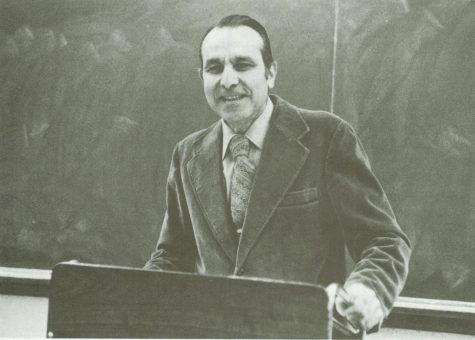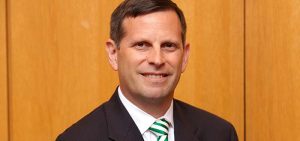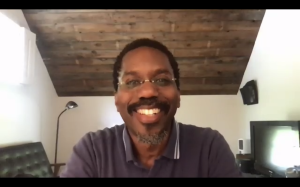‘Beating Heart of Fordham’ Joseph Cammarosano Passes Away at 97
COURTESY OF BUD GLICK
Cammarosano held many jobs in his Fordham career, including a professor of economics and the university’s first faculty senate president.
June 23, 2020
Joseph Cammarosano, Ph.D., a Fordham alumnus, former administrator and economics professor emeritus, passed away from congestive heart failure on May 19 at South Nassau Community Hospital in Oceanside, New York. He was 97 years old.
Cammarosano was born on March 12, 1923, and raised in Mount Vernon, New York. He originally enrolled at Fordham in 1941 but left to serve as a member of the Army Signal Corps in World War II. He returned in 1945 and graduated from Fordham College at Rose Hill (FCRH) in 1947 with a degree in economics. After completing a master’s degree at New York University, he returned to Fordham and began teaching economics in 1955.
Fondly known by his students and colleagues as “Dr. C,” his work at Fordham had profound effects on the personal growth of those he came in contact with. Matthew Burns, associate director for young alumni and student engagement at Fordham and FCRH ’13, took a class with Cammarosano during his freshman year. Burns spoke highly of his former professor, noting that he was a formative part of his educational experience.
“My God, did Joe Cammarosano teach. The man was four times our age but undoubtedly possessed four times our energy. And that energy was only matched by his humility … I have no doubt he’d be at the forefront of our current important work had it happened in his day,” he said.
North Callahan, FCRH ’72, shared a similar sentiment about his former professor, noting his contributions to the university as well as his engaging courses.
“Not only was he instrumental in the growth of the university, if you experienced one of his courses, it was very challenging, and in the end, you reached the conclusion that you were fortunate to have crossed paths with him,” Callahan said. “He was a gifted professor and administrator, but above all a very good man.”

When he joined the economics department in 1971, Dominick Salvatore, Ph.D., met Cammarosano, and he recalled the blend of rigor and joviality with which his colleague taught. He told Fordham News that when a student said that he reminded them of Cammarosano, it was the “greatest compliment.”
Cammarosano seemingly set the precedent for attending Fordham, as many of his children and grandchildren attended the university in the following years and witnessed his widespread influence. His granddaughter, Danielle Cammarosano, Gabelli School of Business (GSB) ’19, was no stranger to professors asking her if she was related to Cammarosano.
Due to his humble nature, she was not aware of how many lives he’d touched prior to arriving at Fordham. She spoke of his unwavering commitment and care for his students with pride, recalling the long line of students outside of his office when she came to visit at the end of the week.
“He would never turn a student away. He would stay in his office, giving each student the same level of attention, no matter the time or their place in line. I would implore him to ask them to come back on Tuesday, but he would not hear of it. ‘By appointment only’ was never part of his syllabus,” she said.
Cammarosano also served as the university’s first faculty senate president and as an executive vice president, guiding Fordham through several pivotal moments. He was appointed as the first faculty senate president after serving as an economist in the U.S. Bureau of the Budget during the Kennedy administration, followed by a role in the New York State Department of Taxation.
When the United States faced an economic crisis in 1968, a number of American universities, including Fordham, faced a period of financial unrest. Cammarosano was named executive vice president and played a key role in saving the university from complete bankruptcy.
According to Roger Wines, Ph.D., FCRH ’54 and history professor emeritus, who served on his budget committee during this time, Cammarosano was able to save the university from a financial crisis without firing any employees.
Opposition to the Vietnam War during the 1960s and into the 1970s brought student protests to Fordham, which Cammarosano navigated by establishing trust among the faculty, the Jesuit community and the student body. Between the financial crisis and student demonstrations, he was described as a “rock of strength” by his colleague Monsignor Thomas J. Shelley, Ph.D., professor emeritus of theology.
Another monumental shift incited by Cammarosano occurred when he introduced the Higher Education Opportunity Program (HEOP) to Fordham, which was created in 1969. The university’s longstanding history of providing aid to underprivileged students would not have been possible without him.
When funding was threatened by the state’s proposed cuts, Cammarosano organized meetings with Fordham faculty members. Strong lobbying efforts rose out of these meetings, including faculty members writing letters to elected officials in support of restoration of funds for HEOP at Fordham.
His commitment to the university and all its inhabitants was echoed not only by his colleagues but also by University President Rev. Joseph M. McShane, S.J.
“Joe was the beating heart of Fordham. He was supremely competent, tough-minded, and unfailingly kind and generous. He cared for the Fordham community deeply and was intensely loyal to the institution and its faculty, students, and staff,” McShane stated in an email to the Fordham community.
Cammarosano is survived by his daughter Nancy Hartzband, FCRH ’77 and Fordham Law ’83, and her three children, as well as his son Joseph R. Cammarosano, FCRH ’78 and Fordham Law ’81, and his two children. Two of Cammarosano’s grandchildren are Fordham alumni as well: Alex Hartzband, Fordham Law ’15; and Danielle Cammarosano, GSB ’19.
Following a private funeral service, Cammarosano was buried at the Gate of Heaven Cemetery in Hawthorne, New York. The university will celebrate a memorial Mass in his honor at a future date.

















Kevin • Oct 1, 2020 at 10:04 am
He was my intro to macro teacher in the late 2000s. I ended up majoring in econ. Those stories about his energy are totally true! I just looked him up because I mentioned him in a job interview I had yesterday. RIP.